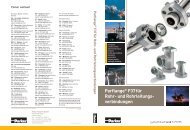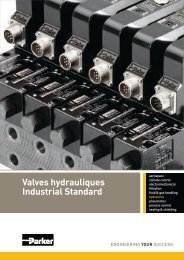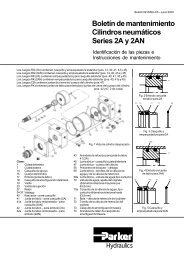Vaporizable Dielectric Fluid Cooling of IGBT Power Semiconductors ...
Vaporizable Dielectric Fluid Cooling of IGBT Power Semiconductors ...
Vaporizable Dielectric Fluid Cooling of IGBT Power Semiconductors ...
You also want an ePaper? Increase the reach of your titles
YUMPU automatically turns print PDFs into web optimized ePapers that Google loves.
The system design engineer may set the dielectric liquid<br />
coolant saturation temperature by adjusting the system<br />
operating pressure. This has a principal benefit for thermal<br />
management and system component design and cost:<br />
• System fluid saturation temperature can be increased<br />
by setting a higher system operating pressure;<br />
• A higher fluid saturation temperature will enable a<br />
higher junction temperature (within the limits <strong>of</strong> the device to<br />
be cooled);<br />
• Setting a higher operating temperature (where feasible<br />
for devices) adds another attribute for system design: either a<br />
smaller condenser can be used, further reducing system size, or<br />
a lower airflow can be set, reducing acoustic noise and power<br />
consumption or the ability to dissipate in high ambient<br />
conditions.<br />
Other key points <strong>of</strong> the VDF cooling loop concept that<br />
affect system design are:<br />
• System is gravity fed;<br />
• Pump must be located below liquid cold plates in the<br />
same cooling loop;<br />
• Heat exchanger must be located above cold plates;<br />
• Heat exchanger may be fluid-to-air (traditional tubeand-fin<br />
style) or fluid-to-water (shell-and-tube for external<br />
chilled water or cooling tower).<br />
• Liquid cooling is employed for the critical high heat<br />
sources in typical system design with air cooling for parasitic<br />
heating in other areas, such as capacitors; these decisions are<br />
design-specific.<br />
D. Maximum Coolant Operating Temperatures<br />
While a two-phase pumped system is a pressurized system,<br />
it is important to note that there is no use <strong>of</strong> a compressor;<br />
therefore, there is also no opportunity to operate at sub-ambient<br />
temperatures. The minimum fluid temperature in pumped twophase<br />
system will be the heat exchanger medium temperature.<br />
This will reflect whatever system operating pressure has been<br />
selected for an expected maximum system ambient temperature<br />
design point.<br />
This is particularly important in the discussion <strong>of</strong> vehicle<br />
systems where a battery pack or ultracapacitor bank must also<br />
be cooled. For lithium-ion battery packs which require a<br />
maximum operating temperature <strong>of</strong> 40°C, for example, an<br />
assumption that a heavy truck or construction vehicle must<br />
operate in ambient outdoor temperatures as high as 32-35°C<br />
would suggest that only vapor compression cycle refrigeration<br />
systems will provide reasonable cooling for the battery pack.<br />
Ideally, a single liquid cooling system to cool both the<br />
inverter(s) for a hybrid vehicle powertrain system and the<br />
battery pack would reduce system complexity and cost.<br />
However, the limited thermal design headroom available for<br />
battery pack cooling, in an assumed 32-35°C outdoor ambient<br />
temperature, will require that other design considerations will<br />
be needed to maintain a 40°C maximum battery pack enclosure<br />
temperature. For ultracapacitor banks and other types <strong>of</strong><br />
battery technologies where maximum operating temperature is<br />
not so tightly limited, a two-phase pumped liquid cooling<br />
system may be an appropriate selection.<br />
These VDF cooling systems are considered to be<br />
refrigerant-agnostic; a number <strong>of</strong> other vaporizable dielectric<br />
fluids can be used or will become available, such as HFO-<br />
1234yf. One example is where very high system operating<br />
temperatures must be anticipated; the solution may be selection<br />
<strong>of</strong> a refrigerant with a chemistry developed for very high<br />
temperature regimes.<br />
Certain types <strong>of</strong> power electronic systems must be designed<br />
for unusually high temperature operating conditions, either for<br />
pulsed operation or for other requirements. When water is used<br />
in such systems (if possible), concern for algae and other<br />
biological growth requires use <strong>of</strong> algaecides and biocides; a<br />
pulsed laser system is one example. Typically, no biological<br />
control agent or other control additive is needed for two-phase<br />
dielectric liquid systems which utilize a coolant such as R-134a<br />
or HFO-1234yf (intended as a future drop-in replacement).<br />
E. Minimum Coolant Operating Temperatures<br />
A refrigerant or other vaporizable dielectric fluid used in<br />
place <strong>of</strong> water as a coolant for electronic systems does not<br />
require addition <strong>of</strong> ethylene glycol for temperature protection,<br />
even for subzero temperatures. Therefore, no thermal derating<br />
is required. Derating can be substantial for glycol/water<br />
systems, rising to derating values <strong>of</strong> 35% or greater for the<br />
most challenging railroad traction values (such as may be<br />
quoted per railroad cold-start requirements <strong>of</strong> -55°C for<br />
railroad locomotives supplied to Russia).<br />
III. PROTOTYPE 750KW/1000HP DRIVE SYSTEM DESIGN<br />
A. System Design<br />
A complete three-phase electrical drive system was<br />
developed for industrial and commercial applications,<br />
incorporating different thermal solutions for the primary heat<br />
sources, the individual <strong>IGBT</strong> semiconductor devices. While<br />
this system design is intended for a large stationary industrial<br />
drive system, the thermal management system design and<br />
performance can be described and results compared to water<br />
cooling systems. These comparisons are useful for analysis <strong>of</strong><br />
performance, prior to system compaction and fitting to vehicle<br />
system requirements for HEV inverters and related subsystems.<br />
Each cooling system configuration was tested utilizing the<br />
same <strong>IGBT</strong> module type, a dual 1700V 450A module packaged<br />
in an industry-standard package design referred to as the<br />
EconoDUAL design. [10] A similar package design is<br />
common to several semiconductor manufacturers. The module<br />
footprint measures approximately 122m in length and 62mm in<br />
width; these modules have a large, flat nickel-plated copper<br />
base plate <strong>of</strong> standard thickness as the primary heat-spreading<br />
component for the module itself.<br />
Typically, six large <strong>IGBT</strong> die and six smaller diode die are<br />
arrayed in format consisting <strong>of</strong> two <strong>IGBT</strong> die and two diode die<br />
each, soldered onto a direct bond copper (DBC) substrate<br />
containing a ceramic dielectric layer and an additional layer





